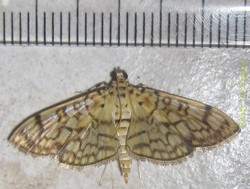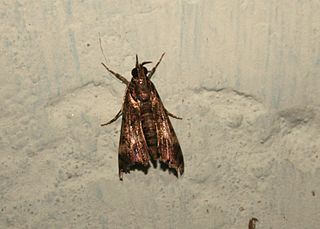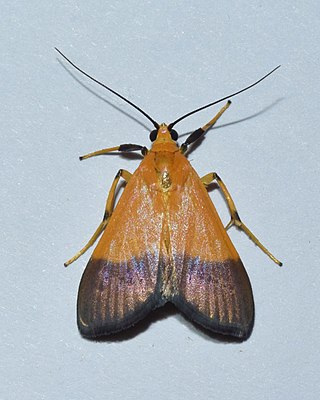
Glyphodes bivitralis is a moth of the family Crambidae described by Achille Guenée in 1854. It is native to south-east Asia, including Hong Kong, India, Japan, Taiwan and Thailand. It is also found in Queensland, Hawaii and Maldives.

Haritalodes derogata, the cotton leaf roller or okra leaf roller, is a species of moth of the family Crambidae. It was described by Johan Christian Fabricius in 1775. It is widely distributed. Records include the Comoros, the Democratic Republic of the Congo, Ghana, Mali, Réunion, Madagascar, the Seychelles, South Africa, the Gambia, Australia, Fiji, Papua New Guinea, Samoa, the Solomon Islands, the Andaman Islands, Bali, India, Sri Lanka, Malaysia, Myanmar, Singapore, Sri Lanka, Vietnam, China and Japan. It is sometimes encountered in Europe, due to accidental import.

Cydalima perspectalis or the box tree moth is a species of moth of the family Crambidae, first described by Francis Walker, the English entomologist, in 1859. Native to Japan, China, Taiwan, Korea, far-east Russia and India, it has invaded Europe; first recorded in Germany in 2006, then Switzerland and the Netherlands in 2007, Great Britain in 2008, France and Austria in 2009, Hungary in 2011, then Romania, and Spain. It has been seen in Slovakia, Belgium and Croatia.

Botyodes diniasalis is a species of moth in the family Crambidae. It is found on the Canary Islands, as well as in Taiwan, China, Japan and Russia. It has also been recorded from Mali, South Africa and the Himalaya.

Herpetogramma basalis is a species of moth in the family Crambidae. It is found on the Canary Islands and in Japan, China, Australia, Sri Lanka, India, Indonesia, La Réunion, South Africa, and Mali.
Glyphodes shafferorum is a moth of the family Crambidae described by Pierre Viette in 1987. It is found on the Comoros, Réunion, Madagascar and in Mauritius and South Africa. Their wingspan is about 20–30 mm.

Noorda blitealis is a species of moth of the family Crambidae. It is found in subtropical Africa, south of the Sahara and in Australasia.
Analyta calligrammalis is a species of moth of the family Crambidae. It is found in Sierra Leone, Ghana, Madagascar, Seychelles as well as in Cameroon, The Gambia, Nigeria, South Africa, and Mali.
Pramadea ovialis is a moth in the family Crambidae that is found in subtropical eastern and southern Africa, including islands of the Indian Ocean. The species has also been recorded from West Africa.
Glyphodes bitriangulalis is a moth of the family Crambidae described by Max Gaede in 1917. It is found in South Africa (Gauteng), Zimbabwe, and Mali.
Euclasta warreni is a moth in the family Crambidae. It was described by William Lucas Distant in 1892. It is found in the Democratic Republic of the Congo, Ethiopia, South Africa, Zimbabwe, and Mali.
Ghesquierellana hirtusalis is a moth in the family Crambidae. It was described by Francis Walker in 1859. It is found on the Comoros (Mohéli) and in the Democratic Republic of the Congo, Ethiopia, Réunion, Madagascar, Sierra Leone, South Africa, Zimbabwe, and Mali.

Glyphodes caesalis is a moth in the family Crambidae. It was described by Francis Walker in 1859. It is found in Sri Lanka, mainland India, Myanmar, the Andaman Islands, New Guinea, Bangladesh, Fiji, Hong Kong, Thailand and Australia (Queensland).

Glyphodes pyloalis, the lesser mulberry snout moth, lesser mulberry pyralid or beautiful glyphodes moth, is a moth in the family Crambidae. It was described by Francis Walker in 1859. It is found in Iran, China, Japan, India, Indonesia (Sumatra), Sri Lanka, Taiwan, the Democratic Republic of the Congo, Equatorial Guinea, Mozambique and North America, where it has been recorded from Florida, Maryland, North Carolina, South Carolina and Virginia.
Glyphodes basifascialis is a moth in the family Crambidae. It was described by George Hampson in 1899. It is found in Australia, Cameroon, the Democratic Republic of the Congo, the Seychelles, South Africa and Tanzania.
Glyphodes cosmarcha is a moth in the family Crambidae. It was described by Edward Meyrick in 1887. It is found in Thailand, New Guinea and in Australia, where it has been recorded from Queensland and New South Wales.
Herpetogramma stultalis is a species of moth in the family Crambidae. It was described by Francis Walker in 1859. It is found in Malaysia, India, Sri Lanka, China, Japan, Pakistan, Papua New Guinea and Australia, where it has been recorded from Queensland. In Africa, it has been recorded from the Democratic Republic of the Congo and Réunion.

Pycnarmon meritalis is a moth in the family Crambidae. It was described by Francis Walker in 1859. It is found in Democratic Republic of the Congo, South Africa, Australia, China, Sri Lanka, India, Indonesia, Taiwan and Japan.

Ulopeza conigeralis is a species of moth in the family Crambidae. It was described by Philipp Christoph Zeller in 1852. It is found in Cameroon, the Republic of the Congo, the Democratic Republic of the Congo, Equatorial Guinea, Ethiopia, Ghana, Ivory Coast, Mali, Nigeria, Sierra Leone, South Africa and Zambia.











